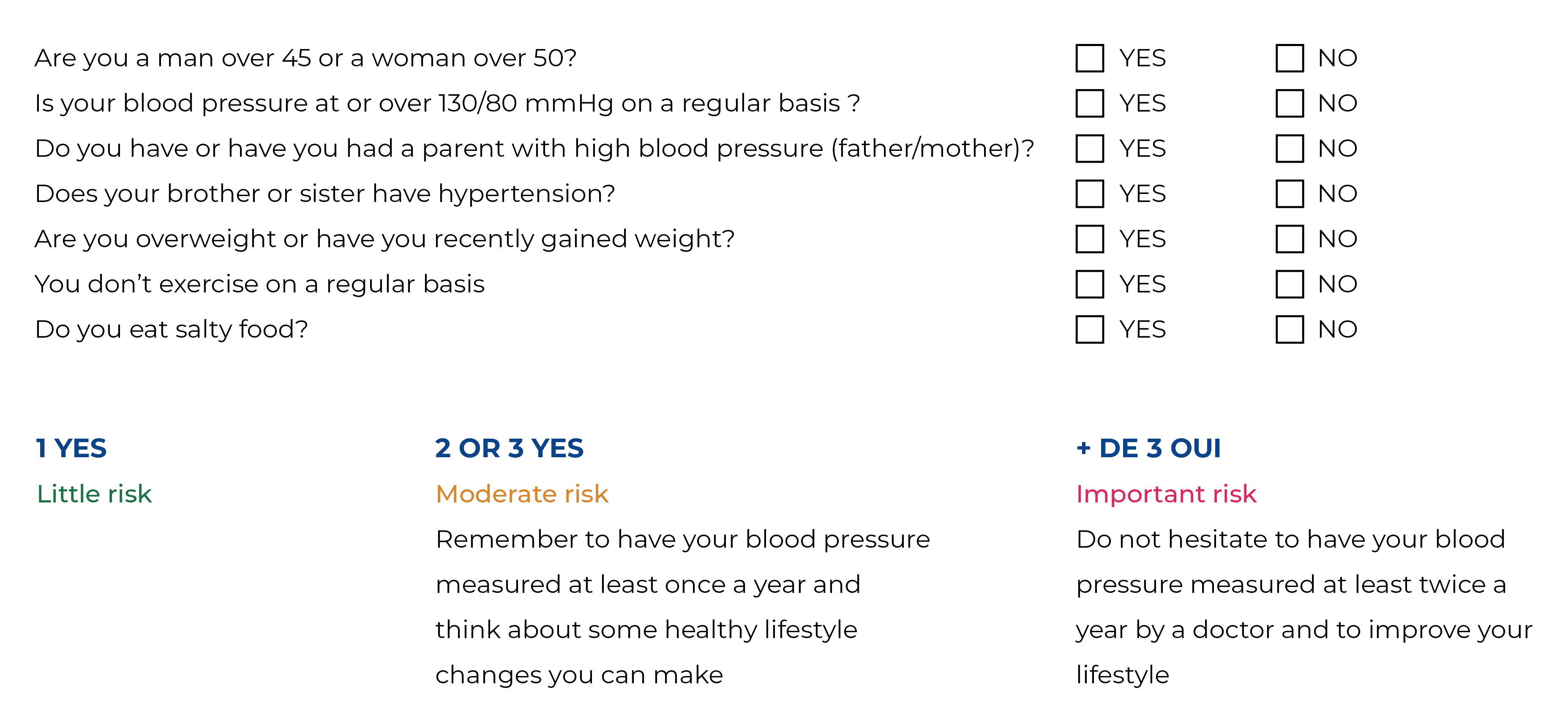Hypertension #2 - How to properly measure and monitor your blood pressure ?
Hypertension is the number one chronic disease in the world and can lead to serious complications. It is therefore essential to determine your risk of hypertension, to understand the different risk factors for this disease and to monitor your blood pressure on a regular basis [1].

Posted on
How to properly measure and monitor your blood pressure?
Hypertension is the number one chronic disease in the world and can lead to serious complications. Described as a ” silent killer “, it generally has no symptoms. As a result, many people with high blood pressure are unaware of their condition. It is therefore essential to determine your risk of hypertension, to understand the different risk factors for this disease and to monitor your blood pressure on a regular basis [1].
Assessing the risk of becoming hypertensive
We would like to suggest a short form that will allow you to assess your risk of developing hypertension [2]. Please note that this form does not replace a medical opinion and does not qualify as a diagnosis. To obtain a diagnosis, consult your physician:

Understanding the risk factors for hypertension
Hypertension is caused by a combination of factors whose effects add up and accumulate over time [2] :
Age
The older we get, the more rigid our arteries tend to become. The more rigid the arteries, the higher the blood pressure.
Heredity
If one of your parents has high blood pressure, the risk of becoming hypertensive yourself is multiplied by 2.
Obesity and lack of physical activity
Weight gain is often associated with an increase in blood pressure, which can lead to actual hypertension. Abdominal obesity is present in more than one out of two hypertensive people. Lack of physical activity promotes weight gain and obesity, especially before the age of 50.
Salty diet
In 40% of hypertensive patients, excessive salt consumption contributes to high blood pressure. In hypertensive patients, it is recommended to have a salt intake of less than 6g per day.
Alcohol
Excessive alcohol consumption (more than two drinks per day in women and three in men) increases blood pressure and may cause some antihypertensive drugs to be ineffective.
Tobacco
Tobacco produces substances that damage the arteries and increase the deposit of cholesterol plaques. These build up inside the vessels and obstruct the flow of blood. As a result, blood pressure increases. Continuing to smoke when you have high blood pressure therefore greatly increases the risk of a cardiovascular accident.
Stress
Even if it is not the only cause of hypertension, it causes an increase in blood pressure.
Poor sleep
Disturbed sleep does not provide an optimal recovery phase for the body and leads to impaired blood pressure control.
Many of these risk factors can be avoided. It is therefore important to identify them in order to be able to control them and thus reduce the risk of high blood pressure. For example: by implementing hygienic and nutritional measures [2].

Monitor your blood pressure properly
Blood pressure fluctuates during the day: from a low value when sleeping, it becomes higher during the day, especially in case of physical activity, exposure to cold, emotional shock, stress… A single blood pressure measurement is therefore not sufficient to make a diagnosis. Different means are used to measure blood pressure [3] :
Measuring blood pressure at the physician’s or nurse’s office
At least once a year. The physician systematically performs this test during the consultation. The blood pressure targets for this routine test are 140 mmHg for systolic blood pressure and 90 mmHg for diastolic blood pressure (a short reminder on the types of blood pressure : click here).
The anxiety regarding the test or the medical environment can sometimes artificially increase the blood pressure, this situation is called the “white coat” effect.
In case of hypertension and to avoid the “white coat” effect, the results must be validated by new measurements under normal conditions. This time, the tests are carried out at different times of the day and for 24 to 72 hours [3]
Ambulatory blood pressure measurement (ABPM)
This is the most reliable method and it is prescribed by the physician to complete his check-up. An automatic device, usually attached to the belt, is connected to a cuff that measures blood pressure every 15 minutes for 24 hours.
Blood pressure should be less than 135/85 mmHg during the day, 120/70 mmHg during the night and should not exceed an average of 125/80 mmHg over 24 hours [3].
Self-measurement of blood pressure (SMBG)
This method allows patients to monitor their own blood pressure and thus confirm the physician’s diagnosis. It also offers the possibility for patients on antihypertensive drugs to evaluate the effectiveness of their treatment.
5 tips for self-measurement :
- Sit comfortably at a table.
- Relax for a few minutes before your measurement.
- Rule of 3: Take 3 measurements in the morning when you wake up and 3 measurements in the evening right after dinner on 3 consecutive weekdays.
- Write down all your results immediately.
- Calculate the average of the 18 measurements of the 3 days: it should be less than 135/85 mmHg [4].
If the results of these different measurements are higher than the blood pressure targets, your doctor will advise you to take hygienic and nutritional measures. If, despite improvements in your lifestyle, your blood pressure remains too high, you will be invited to take medicines [3].
Sources :
[1] Panorama Mondial de l’Hypertension – OMS – 2013. Disponible sur https://apps.who.int/iris/bitstream/handle/10665/85334/WHO_DCO_WHD_2013.2_fre.pdf?sequence=1&isAllowed=y. Consulté le 06/07/21.
[2] Hypertension artérielle – Fédération Française de Cardiologie. Brochure téléchargeable sur https://fedecardio.org/publications/hypertension-arterielle/. Consulté le 06/07/2021
[3] Hypertension artérielle (HTA) – INSERM. https://www.inserm.fr/information-en-sante/dossiers-information/hypertension-arterielle-hta. Consulté le 06/07/21.
[4] Pratiquer l’automesure de la tension – Comité français de lutte contre l’hypertension artérielle. Disponible sur
http://www.comitehta.org/automesure/comment-pratiquer-lautomesure/
POI 0703-09/22
